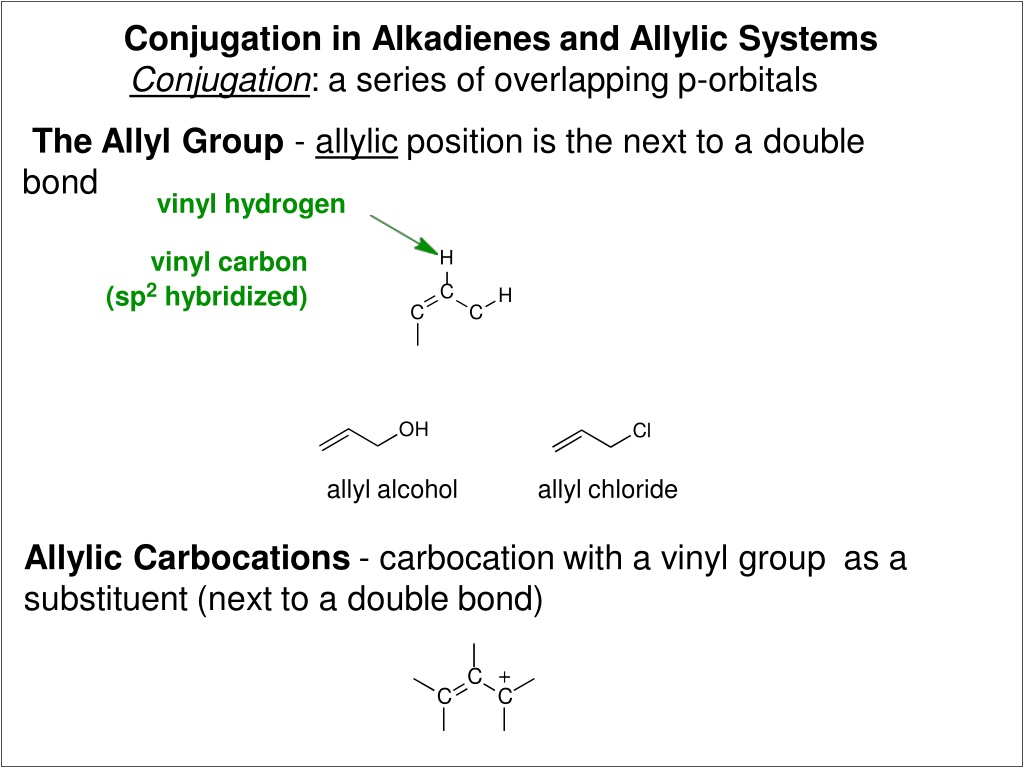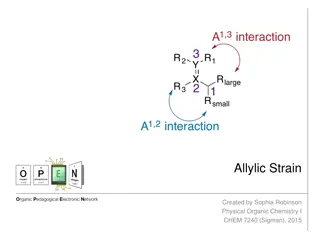Understanding Allylic Systems and Reactions
Conjugation in alkadienes and allylic systems involves overlapping p-orbitals, with the allyl group featuring resonance-stabilized allylic carbocations. Allylic halides exhibit enhanced reactivity in SN1 and SN2 reactions, and allylic free radicals demonstrate distinct electron density patterns. Additionally, the stability of free radicals in allylic systems is influenced by bond dissociation energies.
Download Presentation

Please find below an Image/Link to download the presentation.
The content on the website is provided AS IS for your information and personal use only. It may not be sold, licensed, or shared on other websites without obtaining consent from the author. Download presentation by click this link. If you encounter any issues during the download, it is possible that the publisher has removed the file from their server.
E N D
Presentation Transcript
Conjugation in Alkadienes and Allylic Systems Conjugation: a series of overlapping p-orbitals The Allyl Group - allylic position is the next to a double bond vinyl hydrogen vinyl carbon (sp2 hybridized) H C H C C OH Cl allyl alcohol allyl chloride Allylic Carbocations - carbocation with a vinyl group as a substituent (next to a double bond) C C C
Allyl carbocations are stabilized by resonance C C C C C C C C + + C + C C + C C C C The atoms must remain fixed in all resonance forms. Resonance forms differ only by the placement of electrons No one resonance form is entirely accurate. The actual structure is a hybrid of all the resonance forms. Resonance forms do not necessarily contribute equally to the resonance hybrid.
10.3: SN1 Reactions of Allylic Halides - allylic halides and sulfonates are more reactive toward than simple alkyl halides toward nucleophilic substitution by the SN1 mechanism H H H C H C H CH3 H C CH3 H C C C CH3 H CH3 H H C Cl C CH3 C CH3 Cl C H C CH3 C H CH3 Resonance stabilized carbocation intermediate over 100x more reactive than (H3C)C-Cl H C H CH3 H H CH3 C CH3 H C H C OH C OH CH3 C 85 : 15
10.4: SN2 Reactions of Allylic Halides - allylic halides and sulfonates are more reactive toward than simple alkyl halides toward nucleophilic substitution by the SN2 mechanism H C H C ~ 80x more reactive than Cl-CH2CH2CH2CH3 S 2 H Cl H Nu N C C C C H H H H H H
10.5: Allylic Free Radicals 1/2 C 1/2 C C C C C C C C 1 1/2 bonds Map of the electron density due to the unpaired electron (the spin )
Free Radical Stabilities are Related to Bond-Dissociation Energies 410 kJ/mol H + CH3CH3 CH H CH CH CH H CH3CH2CH2 397 kJ/mol (CH3)2CH + H (CH3)2CH H 380 kJ/mol (CH3)3C (CH3)3C H + H 368 kJ/mol + H2C CHCH2 H2C CHCH2 H H C H bond is weaker in propene because the resulting allyl radical is more stable than the alkyl radicals.
10.6: Allylic Halogenation - Allylic halogenation of an alkene takes place through a free radical mechanism. Br O NBS, h N Br CCl4 O N-bromosuccinimide (NBS)
Limitation: Allylic halogenation is only useful when all of the allylic hydrogens are equivalent and the resonance forms of allylic radical are equivalent. NBS, h Br + Br 10.7: Allylic Anions C C C C C - C C - C C
_ pKa ~ 60 H+ CH3CH2CH2 + + CH3CH3CH H _ pK ~ 43 a + H+ H2C CHCH2 H C CHCH H 2 2 10.8: Classes of Dienes Diene: molecule with two double bonds C-C single bond C C C C=C Cumulated Diene (allene) Alkene Diene double bonds Conjugate Diene Conjugated diene: alternating double and single bonds
10.9: Relative Stabilities of Dienes Recall from Chapter 6 that heats of hydrogenation ( H H2) was used to measure the relative stability of isomeric alkenes Figure 10.4 (p. 396) H2, Catalyst H H2 -126 KJ/mol H2, Catalyst -252 KJ/mol (2 x 126 = 252) H2, Catalyst -111 KJ/mol (126 - 111 = 15) H2, Catalyst -226 KJ/mol the double bonds of conjugated dienes are more stable than isolated double bonds.
10.10: Bonding in Conjugated Dienes When the carbons of a conjugate diene all lie in the same plane, the -molecular orbitals overlap. The four -electrons of a conjugated diene are delocalized over the four p-orbitals _ _ + + Bond lengths in pm H3C CH3 H2C CH2 H2C CH CH CH2 H2C CH CH CH2 H2C CH CH3 146 134 153 133 151
There are three conformations of butadiene. The (lower case) s prefix designates a conformation around single ( ) bond. H C H C H H 180 rotation of the central -bond C C H C C H H H C H H C H H s-trans s-cis The perpendicular conformation is 16 KJ/mol higher in energy than the s-cis 90 rotation of the central -bond Energy The s-cis conformation is 12 KJ/mol higher in energy than the s-trans s-cis s-trans
O H n Vitamin A (retinal) poly-acetylene Arene -carotene lycopene alkenes conjugated to carbonyls O O H acrolein cyclohexenone ( -unsaturated aldehyde, enal) ( -unsaturated ketone, enone) alkenes conjugated to non-bonding pairs of electrons O R O N
10.11: Bonding in Allenes (please read) sp hybridized C C C sp2 hybridized 10.12: Preparation of Dienes Preparation of conjugated dienes (1,3-dienes) from alkenes: allylic bromination followed by dehydrohalogenation Br (CH3)3CO - K+ NBS, h CCl4
10.13: Addition of Hydrogen Halides to Conjugated Dienes Isolated dienes: double bonds react independently. Conjugated dienes: the -bonds of a conjugated diene react as a single unit. Electrophilic Addition to Conjugated Alkenes: The addition of HX to butadiene. Recall that the addition of HX to alkenes follows Markovnikov s Rule The observed product is derived from the most stable carbocation intermediate X X H-X + H3C H3C CH3 H not observed The addition of HX to a conjugated diene occurs to give a resonance stabilized allyl carbocation
H H H Br Br Br Br H H Br The distribution of products is dependent upon temperature 1,2-addition (direct addition) 1,4-addition (conjugate ad dition) 25 C -80 C 44% 81% 56% 19% At low temperature the reaction is under kinetic control, the major product is the one that forms fastest. The reaction is under thermodynamic control at higher temperature, the major product is the most stable.
Figure 10.8 G act (1,2-addition) < G act (1,4-addition) The 1,2-addition product is formed faster than the 1,4-addition products. Kinetics (rate) favors 1,2-addition G (1,4-addition) > G (1,2-addition) The 1,4-addition product is more stable than the 1,2-adition products. Thermo- dynamics favors 1,4-addition
10.14: Halogen Addition to Dienes Electrophilc additions of other electrophile to dienes give similar results Br Br2 + Br Br Br 63 % 37 % 1,4-addition 1,2-addition Br Br2 + + Br Br Br Br Br 3 % 21 % 76 % 1,2-addition 1,2-addition 1,4-addition
10.16: The Molecular Orbitals of Ethylene and 1,3-Butadiene -MO s of ethylene (from Chapter 2) Lowest Unoccupied Molecular Orbital (LUMO) -antibonding MO 2 Highest Occupied Molecular Orbital (HOMO) -bonding MO 1
-molecular orbitals of butadiene 3 Nodes 0 bonding interactions 3 antibonding interactions ANTIBONDING MO 2 Nodes 1 bonding interactions 2 antibonding interactions ANTIBONDING MO 1 Nodes 2 bonding interactions 1 antibonding interactions BONDING MO 0 Nodes 3 bonding interactions 0 antibonding interactions BONDING MO 2 is the Highest Occupied Molecular Orbital (HOMO) 3 is the Lowest Unoccupied Molecular Orbital (LUMO)
Molecular orbitals of conjugated polyenes Antibonding Energy Bonding H2C CH2 290 nm 217 nm 258 nm 180 nm 380 nm 400 nm 450 nm 550 nm 600 nm 780 nm 500 nm 700 nm green orange red blue yellow violet-indigo
The Diels-Alder Reaction (a very important reaction) - Reaction between a conjugated diene and an alkene (dienophile) to give a cyclohexene. Dienophile Diene cyclohexene transition state Mechanism: concerted - reaction (bond breaking and bond forming) takes place in a single step. Cycloaddition - non-cyclic reactant react to form a cyclic product Pericyclic - cyclic aromatic-like transition state = Benzene Diels-Alder Transition State
The Diels-Alder reaction is favored by electron withdrawing groups on the dienophile and electron donating groups on the diene. H H O O O R OR H H H ethylene (unreactive) conjugated carbonyls (aldehydes, ketones and esters) O O N CO2R C O O O Good dienophiles The diene must adopt an s-cis conformation to be reactive: s-trans s-cis very unreactive diene very reactive diene (unreactive conformation) (reactive conformation)
Stereochemistry of the Diels-Alder Reaction: The stereochemistry of the alkene reactants (dienophile) is preserved in the product. O O H H + O O H H O O O O H H CH3 + CH3 H H3C H CH 3 O O H H CH3 + CH3 CH3 H CH3 H
10.17: A Molecular Orbital Analysis of the Diels-Alder Reaction 2 of butadiene HOMO diene 2 of ethylene LUMO dienophile The orbitals between the diene and dienophile involved in bond formation are in phase - symmetry allowed. HOMO orbitals are out of phase CH2 CH2 CH2 CH2 LUMO Symmetry forbidden























